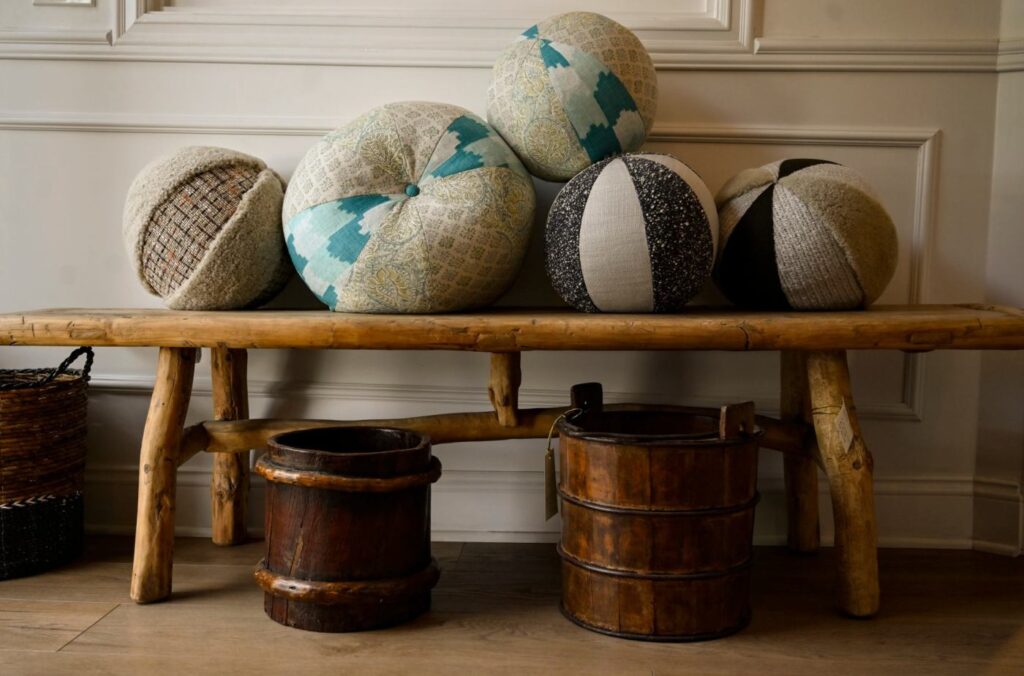
In just three-and-a-half years, Debbie Ouyang and Julie Benniardi have collected over 11,000 pounds of fabric from Los Angeles’ interior design showrooms. The Pasadena-based team behind fashion and home goods brand Reweave L.A. stores some of those textiles in their respective homes and more in their warehouse. They turn those scraps of fabric into luxe patchwork pillows and throws, comfy, puppy-friendly BFF beds for pets and chic, upholstered stools.
Reweave L.A. began when Ouyang asked Benniardi, an interior designer, what happens to the sample fabrics in showrooms after seasons have passed. Benniardi did some digging and found out that, while some fabrics are donated to art and design schools, much was discarded.
“We thought it would be such a huge waste to throw these beautiful pieces away,” says Benniardi.
Today, you can find Reweave L.A. pieces through the company’s website, at designer showrooms in Los Angeles and New York and at select boutiques like Hollis in San Marino.
By upcycling samples, Reweave L.A. offers readymade pieces using fabrics that are typically used in custom work. And since the quantity of the specific fabrics are limited, pieces may be one-of-a-kind. More importantly, though, Reweave L.A. is keeping some textiles out of the local waste stream and that’s important.
Whether you’re buying upcycled products, thrifting for home decor or refurbishing what you already own, redoing your home with second-life items is an ideal way to reduce the amount of trash in our clogged waste streams. According to 2018 numbers from the EPA, about 11.3 million tons of textile waste end up in landfills. While a lot of that weight comes from clothing, home items also contribute to the haul. The same report indicated that over a million tons of towels, sheets and pillowcases head to landfills. Meanwhile, when it came to durable goods – a category that includes appliances, furniture and carpet – over 37 million tons went to landfills.
Reducing the footprint
Upcycling isn’t just good for keeping items out of the garbage. “The majority of an item’s carbon footprint currently comes from the first time that item is produced,” says Suay Sew Shop founder Lindsay Rose Medoff, who has been working in remade and upcycled fashion and home goods for 17 years.
On the bank of the Frogtown stretch of the L.A. River, Suay Sew Shop makes and sells a variety of home goods, ranging from napkins to body pillows, from textiles that might otherwise be trashed. They source fabrics from vintage and deadstock items, as well as from local post-consumer waste brought in through their own recycling program. The textiles are also used to give a facelift to secondhand furniture. In addition to their readymade items, Suay also handles custom jobs, like upholstery and quilt-making, with upcycled fabric.
If you’re considering environmental impact when you shop for your home, buying items made with sustainably sourced materials is good, but buying items made from things that already exist is better. But as Medoff points out, there’s a drawback to the market for remade or upcycled goods. “It prices the majority of people out,” she says. That’s a problem for anyone who wants to use their spending power to support Earth-friendly practices, but whose budget only allows for mass-produced items on sale at big box stores.
Suay is working to make upcycled home goods more accessible through a few different programs. One is the Community Dye Bath. Every month, the shop offers a few different colors available to dye your items. Customers bring in their clothing, towels and sheets, paying $16 a pound to have it added to the bath. Meanwhile, Suay’s repair and alteration program has become a popular way for customers to revive their torn duvets, which the company’s skilled sewers can repair in ways that will fit your personal style.
Upcycling your own home items, of course, is a budget-friendly way to create less waste. But what if you don’t know how to revive your home items?
Related Articles
5 tips to save you money in the garden
Why gardeners are praising the toughness of this resilient fruit tree
Drip irrigation, azaleas and pineapples: 5 things to do this week in the garden
5 houseplant trends, from pops of color to macrame
What to plant on a slope for erosion control
Remaking the old
In Glendora, Michele Rivard has been teaching people how to do that for over a decade.
Rivard is the owner of Knot Too Shabby, where she sells the vintage finds that she refurbishes, as well as DIY supplies. “What my real objective is is to encourage people and empower them to do it themselves,” she says. Knot Too Shabby offers workshops for people of all skill levels to learn basic and more advanced painting techniques.
“Most people take a paint class because they have not just a single project to do, but they have a lot of projects to work on,” she says, adding that people are often working on sentimental items and want to make sure that they’re repainting them properly. Rivard says that even more than environmental concerns, people are motivated to hang onto older pieces because of the quality of items made before the fast furniture era. “You’ve got good pieces that are going to live well and have proven that they can withstand all that life throws at and that’s not the case of new furniture that you pick up from Ashley Furniture or Living Spaces,” she says.
Then, she says, there’s the feeling that comes with being able to remake what you already have.
“It feels good to take something that you have that you don’t like and turn it into something that you love,” she says. “There’s a lot of personal gratification in having completed that yourself.”
